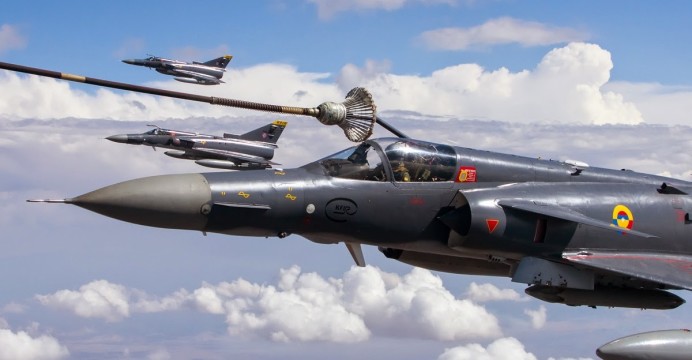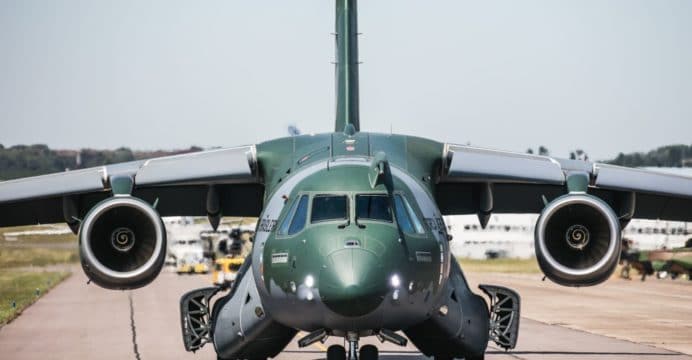Despite selecting refurbished Kfirs from in 2015, is unable to ink a deal. Another opportunity for to market the JF-17???

ARGENTINA REPORTEDLY HALTS (ON-AND-OFF) IAI KFIR BLOCK-60 TALKS
reports that Argentina has – again – halted negotiations for 12-14 Israel Aerospace Industries (IAI) Kfir Block-60 multi-role fighters. Argentina had in March.
It is not known why Argentina had walked away from negotiations. News reports to technical concerns over the aircraft and regulatory concerns regarding the transfer of American systems, such as General Electric J79 turbojet engines. Pricing was also an issue.
The Argentinian Air Force is currently undergoing a recapitalization program involving the acquisition of new aircraft, among them trainers and helicopters.
In April, Argentina for four Beechcraft T-6C Texan II trainers for $88.2 million U.S. In 2016 the U.S. had approved the sale of 24 T-6C trainers to Argentina for $300 million (with requisite logistics, training and after-sale support). Argentina could order another eight T-6Cs in the near-term.
However, the pursuit of a next-generation combat aircraft platform to replace the Argentinian Air Force’s Lockheed Martin A-4ARs has been a perennial challenge. Buenos Aires had for possible successors, even including non-traditional options from Russia and China.
Argentina had even the Aviation Industry Corporation of China (AVIC) and Pakistan Aeronautical Complex (PAC) regarding the . However, Buenos Aires walked away from the platform, due to the risk of cost-escalation from incorporating Western avionics.
Since then, Argentina has been pursuing the IAI Kfir Block-60. The marquee feature of the Kfir Block-60 is that is that is available with the Elta EL/M-2052 active electronically-scanned array (AESA) radar.
Notes & Comments:
While matters fell through the previous time, Argentina may remain as one of AVIC and PAC’s standard-bearer markets for the JF-17. Simply put, it would be a gateway to the Latin American market, which is in the process of region-wide defence modernization and acquisition efforts.
The JF-17 program has seen substantive progress since Argentina had expressed interest in the platform. With more than 70 aircraft in service with , PAC is at the second-half of the JF-17 Block-II’s production run. Unlike the JF-17 Block-I, the Block-II is a noticeably customized variant comprising of a mix of Chinese, Western and other electronic subsystems. The – for operational conversion training – has also flown.
Chengdu Aircraft Industry Group (CAIG) and PAC are also progressing with the , which will be the first major update to the Thunder platform. It will include an AESA radar and, if the , increased wingspan (for additional stores), reduced wing-loading and three-axis digital fly-by-wire flight control system. While the AESA radar is likely to be Chinese, the PAF could potentially look to further tune the aircraft by incorporating additional third-party subsystems. The integration of from Turkey’s Aselsan is an example of this effort.
It is possible that the PAF’s own JF-17 Block-III could align (at least nearer than the Block-I/II) to Argentina’s preferred (Western oriented) configuration. Granted, avionics inputs would have to come from Western vendors that are comfortable with the JF-17, such as Aselsan and Indra. This limits Argentina’s options.
A non-Chinese radar will be a challenge. The issue with a third-party radar (e.g. Leonardo Vixen 1000E) is sourcing medium-range air-to-air missiles (MRAAM) and anti-ship missiles (AShM) from non-Chinese sources. MBDA would necessitate British approval (an obstacle for Argentina), while plausible alternates – e.g. Turkey’s Bozdogan MRAAM and Atmaca AShM – are in the development stage.
If technical aspects are addressed, financing may not be insurmountable. For example, PAC can offer the Argentinian Air Force low-rate or incremental purchasing options (e.g. as was offered to Nigeria). Most of PAC’s production line will support PAF requirements, it is not export-dependent.
I have very low expectation of JF-17 for Argentina, although JF-17 may be a better option than refurbished kfir.
JF-17 is better because everything of it is new. It has very high Performance/Price ratio because of the full set of Chinese Radar, avionics and weapon suite. All the works (time and money) of integration and testing have been done(paid) by PAC and CAC.
Buying the airframe and engine then replace and integrate radar, avionics and weapon suite from multiple western vendors will greatly increase the cost regardless who does that job. Therefor diminishing the P/P ratio, the point that Argentina is looking for. Considering the limitation and potential pressure from UK to the various vendors, the price of doing it will be even higher than usual (hypothetically JF-17 + Indra to Brazil).
If Argentinians insist on their preference for western systems, I don't see them having any choice other than no air-force at all. This sounds too harsh, but reality is harsh, everything costs.



